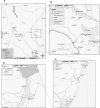Rift Valley fever virus epidemic in Kenya, 2006/2007: the entomologic investigations
- PMID: 20682903
- PMCID: PMC2913497
- DOI: 10.4269/ajtmh.2010.09-0319
Rift Valley fever virus epidemic in Kenya, 2006/2007: the entomologic investigations
Abstract
In December 2006, Rift Valley fever (RVF) was diagnosed in humans in Garissa Hospital, Kenya and an outbreak reported affecting 11 districts. Entomologic surveillance was performed in four districts to determine the epidemic/epizootic vectors of RVF virus (RVFV). Approximately 297,000 mosquitoes were collected, 164,626 identified to species, 72,058 sorted into 3,003 pools and tested for RVFV by reverse transcription-polymerase chain reaction. Seventy-seven pools representing 10 species tested positive for RVFV, including Aedes mcintoshi/circumluteolus (26 pools), Aedes ochraceus (23 pools), Mansonia uniformis (15 pools); Culex poicilipes, Culex bitaeniorhynchus (3 pools each); Anopheles squamosus, Mansonia africana (2 pools each); Culex quinquefasciatus, Culex univittatus, Aedes pembaensis (1 pool each). Positive Ae. pembaensis, Cx. univittatus, and Cx. bitaeniorhynchus was a first time observation. Species composition, densities, and infection varied among districts supporting hypothesis that different mosquito species serve as epizootic/epidemic vectors of RVFV in diverse ecologies, creating a complex epidemiologic pattern in East Africa.
Conflict of interest statement
Disclosure: This manuscript is published with permission from the director, Kenya Medical Research Institute.
Figures

References
-
- Peters CJ, Linthicum KJ. In: Handbook of Zoonoses. Section B: Viral Zoonoses. Second edition. Beran GW, editor. Boca Raton, FL: CRC Press; 1994. pp. 125–138. (Rift Valley fever).
-
- Daubney RJ, Hudson R, Garham PG. Enzootic hepatitis of Rift Valley fever: an undescribed virus disease of sheep cattle and man from East Africa. J. Pathol. Bact. 1931;34:545–579.
-
- Meegan JM, Hoogstraal H, Moussa MI. An epizootic of Rift Valley fever in Egypt, 1977. Vet Rec. 1979;105:124–125. - PubMed
-
- Hoogstraal HJ, Meegan M, Khalil GM, Adham FK. The Rift Valley fever epizootic in Egypt 1977–1978. 2. Ecological and entomological studies. Trans R Soc Trop Med Hyg. 1979;73:624–629. - PubMed
-
- McIntosh BM, Jupp PG, dos Santos I, Barnard BJ. Vector studies on Rift Valley fever virus in South Africa. S Afr Med J. 1980;58:127–132. - PubMed
Publication types
MeSH terms
Substances
LinkOut - more resources
Full Text Sources
Medical

